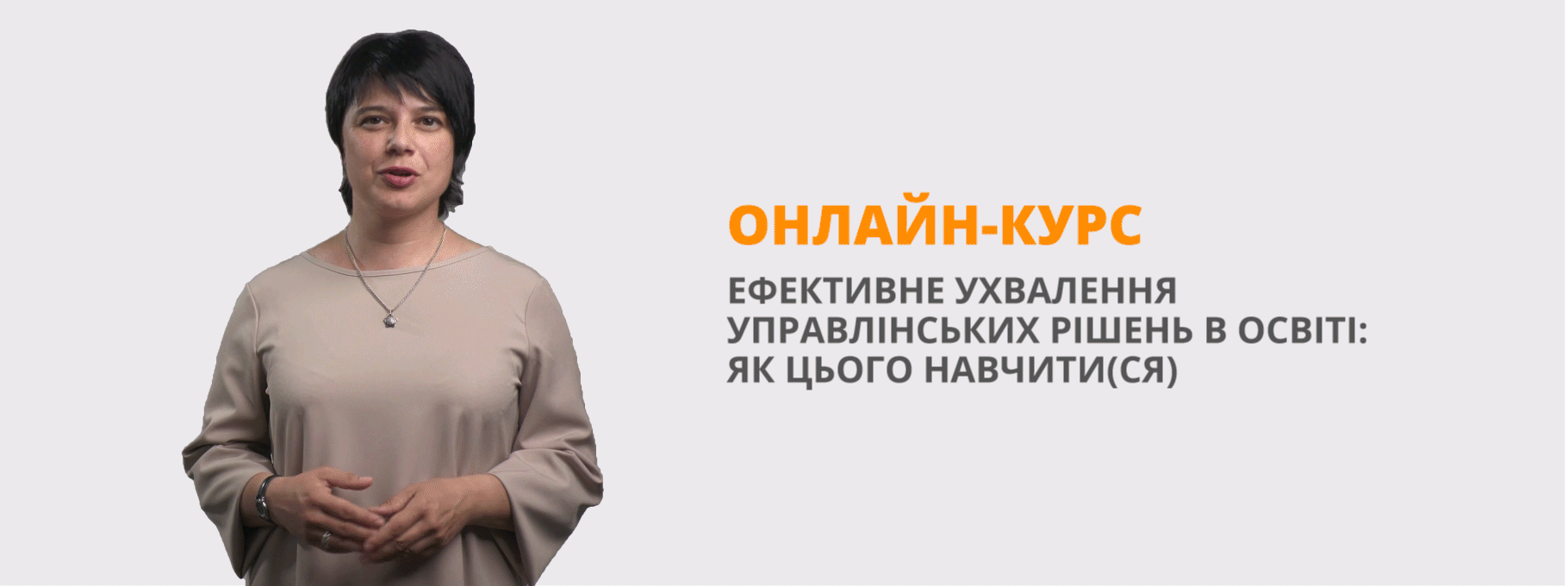Novgorod-Sivers’kyi is an ancient city
Novgorod-Seversky was founded in the tenth century during the reign of Grand Duke Vladimir the Great. It was to be a fortress protective the northern borders of the grand dukes lands. But it was only later that it became the seat of grand dukes. The city became well-known among much later generations thanks a twelfth –century poem The Tale of Igor's Host (the poem was discovered only at the end of the eighteenth century) written by an anonymous poet.
Novgorod-Sivers’kyi medical school
Experimental paper
Novgorod-Sivers’kyi is an ancient city
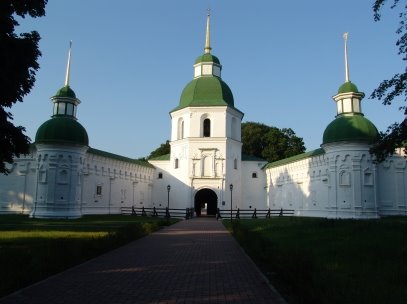
Prepared by
Larysa Dovhoruk
Novgorod-Sivers’kyi
2018
Contents
|
Introduction |
3-4 |
||
|
Chapter I. Novgorod-Sivers’kyi is an ancient city |
|||
|
|
1.1. |
The history of the town |
5 |
|
|
1.2. |
The Prince Igor’s land |
6-9 |
|
|
1.3. |
The nature |
10 |
|
Chapter II. The places of interest. |
|||
|
|
2.1. |
Zamkova Gora |
11-14 |
|
|
2.2. |
The Nikol’s’kay Church |
15-16 |
|
|
2.3. |
The Market places and warehouses |
17 |
|
|
2.4. |
The Uspens’kyi Cathedral |
18-19 |
|
|
2.5. |
The Triumphal arch |
20-21 |
|
|
2.6. |
The Maskuline high school |
22-23 |
|
|
2.7. |
The Novgorod-Sivers’kyi Spaso-Preobrazhens’kyi monastery |
24-25 |
|
|
2.8. |
Some other places of interest |
26 |
|
Conclusion |
27 |
||
|
Literature |
28 |
||
Introduction
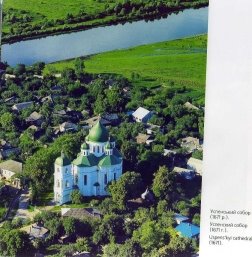
Novgorod-Sivers’kyi is one of the oldest cities of Kyivan Rus’. It is situated on the right bank of the river Desna, in the north-eastern part of Ukraine. Novgorod-Sivers’kyi is the city of the district submission, the center of Novgorod-Sivers’kyi district. The area of the district – 1,8 thousands km2. The distance from Novgorod-Sivers’kyi to Moscow is 715 km., to Kyiv is 340 km., to Chernigiv is 176 km., to the scopes with Russia is 59 km. The population of the district is 39 thousand people.
The territory of the modern city and surrounding locality were populated in early ancient times. The settling began near 40 thousand years ago in a paleolithic era. The average Podesenia by its climatic terms and natural features was especially comfortable for settling by a primitive man. Except for that, on the banks of Desna there was flint in a generous amount, basic raw material, from which a primitive man made tools, e.i. scrapers, punctures and other things. Archaeologists found a late - paleolithic stand, the settlement of the epoch of neolit and bronze, early iron, slavonic settlements and settlements of siverian of the VIII – X centuries here. There are the most famous stands (Pukaravs’ka and Mizyns’ka) on the territory of the district. The scientists of many countries of the world know about their rare exhibits. The stand of paleolith was opened in the city. This stand was disposed in the end of modern street of R.Luxemburg, on the slope of the mountain. The dwelling of a primitive man was disposed here under covers and in the grottoes of sandy flags. Flint chisels, scrapers and other things were found under the layer of forest deposits there. This stand was explored.
The first annalistic mention about the city belongs to 1078 year in "Povchanni Volodumura Monomakha svoim dityam", where he writes, as in winter, in 1078 – 1079 he raided the large detachment of polovtsiv under Novgorod. The large archaeological complex expedition of AN USSR and AN UKRAINE worked under the direction of the candidate of historical sciences Andriy Vasiliy Kuza from 1979 till 1984 years on the territory of Novgorod-Sivers’kyi. The expedition collected the rich archaeological material. The analysis showed that the first defensive buildings of the city were built yet in the end of the Xth century.
This conclusion gets the confirmation in some chronicles. The particular chronicle “Povist’ mynulykh lit” reports about the building by Volodymyr Svyatoslavovich in 988 some townships on the rivers of Desna, Stugna, Sula, Oster. This building was conducted with the purpose of defence of russian lands from any attack of nomads. Novgorod-Sivers’kyi appeared with a strategic purpose, which must have protected the border of Kyivan Rus’ from the south. The archaeological set time of building of the fortifications in Novgorod-Sivers’kyi coincides with the time of building of the annalistic cities built in order of Volodumur. So, as building was conducted some years, the time of its foundation is the 80th years of the Xth century. And now the city entered the second millennium of its existence.
The city carries the double name. The first part of the name was brought to the city by settlers from Novgorod of Large – "men from sloven", the second part is related to the slavonic tribe of siverian, who settled on the banks of the rivers Desna, Sula in the VI - Xth centuries
Due to the amount of the architectural monuments, the city takes the second seat after Chernigiv. In general, 13 monuments of architecture are registered in the town.
[1; 178 – 183]
[5; 6 – 7]
Chapter I. Novgorod – Sivers’kyi is an ancient city.
1.1. The history of the town
This ancient city is situated in the north of the Land of Chernihivshchyna, about fifty kilometers from the northern most tip of Ukraine. Sometimes the city is referred to as a “little Kiev” . If you look at it from the river Desna , you will see steep slopes of the hills, golden and green domes of the churches and bell towers, very similar to the way Kiev looks from the left bank of the Dnipro River. The central hill where the fortified part of town once was, used to be called Detinets; now it is called Zamok, or Zamkova Gora (Mount Castle). A thousand years ago , in 1097, the grand dukes of Kievan Rus-Ukarine held a summit at the town of Lyubech, and one of the dukes, Oleg Svyatoslavovitch, was given the land of Chernihivshchyna to rule, with Novgorod-Seversky as its central city. Oleg soon added to the principality he ruled other possessions in the Lends of Kursk and Bryansk.
Novgorod-Seversky was founded in the tenth century during the reign of Grand Duke Vladimir the Great. It was to be a fortress protective the northern borders of the grand dukes lands. But it was only later that it became the seat of grand dukes. The city became well-known among much later generations thanks a twelfth –century poem The Tale of Igor’s Host (the poem was discovered only at the end of the eighteenth century) written by an anonymous poet.
In the spring of 1185 , Duke Igor Svyatoslavovitch launched a military camping against the Polovtsi nomads. His army marched away from Novgorod-Seversky, the duke’s residence, into the steppe and was destroyed in a battle, and the duke himself was killed. The poem is the one in which Yaroslavna, the duke’s wife, laments his fate.
[1; 178 – 179]
[2; 5 – 6]
[4; 8 – 9]
[5; 6 – 7, 14 – 15]
[6; 15 – 16]
1.2. Prince Igor’s land
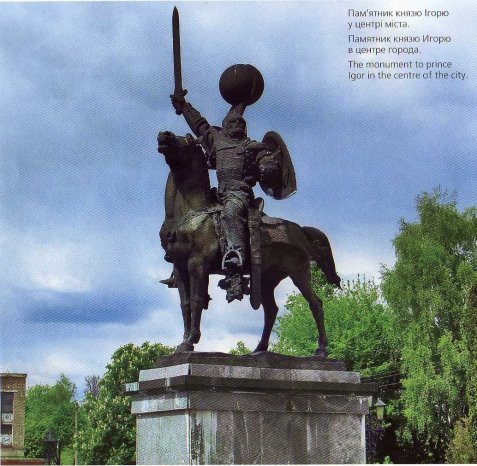
It can be said that the settlement history of today's Novgorod-Sivers'kyi is more deed than the first written mentioning of it. The primeval people settlement, found on Sobornaya Street of our city, on the mountain's slope overhanging Desna, is dated back to the end of the Ice Period. The monuments of the lithic age are found on the city's territory.
Starting with the 6th century A.D., the territory of Novgorod-Sivers'kyi was populated by the Siverian Eastern Slavonic tribe. The remnants of that period are found ancient settlement Zamok. In fact, this fully preserved ancient settlement gave birth to our city..
Novgorod-Sivers'kyi was first mentioned in "Povchanni Volodumura Monomakha svoim dityam" (the Volodumur Monomakh's instructions to his children) which is dated by 1078-1079but even before, in 988, there was the note in "Povist’ mynulykh lit" (the chronicle of the years), that the other Kyiv Prince Volodumur the Great who baptized Kyiv Rus', gave orders to build the cities on "Desna, Oster, Trubezh, Sula and Stugna" in order to prevent the constant raids of nomads. On the highest and steepest hill above Desna, where the former Siverian settlement stood, the unknown builders constructed fortifications. Some time later, the walls and towers of the city-fortification were built.
In 1097, according to the prices' congress in Lubechi, Novgorod-Sivers'kyi became the capital of the Oleg Svyatoslavovich feudal prince lord's princedom; he was the son of the Kyiv Prince Svyatoslav Yaroslavovich. Within the times of the given princedom's existence, this region reached the highest point of its development, by means of iron-working, blacksmith shop, pottery, carpentry and jewelry production development. The following historical cities as Putivl', Kurs'k, Trubachevs'k and Bryans'k constituted the Novgorod-Sivers'k princedom.
The capital saw a lot: the princes' intestine strifes, the nomads' raids. One of the most impressive events was the failed campaign of Prince Igor to "Polovtsiv’s land, for the Russian land" in 1185, which was described in a genius "Slovo о Polku Igorevom" (the story of Igor's military unit) by a talented chronicler-poet. Historical specifics and powerful word, the pain of loss and the same painful topic of that period Rus' land unity characterize this literal monument.
In 1239 the troops of Mongol-Tatar khan Batyi practically ruined Novgorod-sivers'kyi, its churches and sacred places. Archeologists during excavations found and still find the remnants of the former buildings - the remnants of the prince's palace on the mountain Zamkova, the Uspens’kyi Cathedral, which was the first temple on the Spaso-Preobrazhens’kyi monastry's territory.
Bloodless and desolated region became the part of the Great Lithuanian Princedom since 1350, and the part of Russia since 1503. In 1618, according to the Deulins'ktruce, Chernigiv-Sivers'kyi region became the part of Poland, and soon Novgorod-Sivers'kyi became the capital of Chernigiv province.
After the liberation war of the years 1648-1654, the city became the part of the newly established state - Hetmanshchina. Since 1649, Novgorod-Sivers'kyi became the sotnik city of Nizhyns'kyi, and since 1663 - Starodubs'kyi regiments, it became the significant cultural centre.
Just one example. That time the Slavonic-Latin school was established and the print shop, which edited the church and civil books, "Alphabet", was among them, were created and really functioned in Spaso-Preobrazhens'kyi monastery.
In 1782, the city became the centre of the region ruled by governor-general, which included 11 districts and two former Hetman Ukraine capitals - Baturin and Glukhiv. In 1996, Novgorod-Sivers'kyi obtained the status on the district centre of Malorossia and since 1802, of Chernigiv province.
XVII-XVIII centuries turned out to be successful for the Novgorod-Sivers'kyi development. It was broaden and construction took place: the marvelous Uspens'kyi Cathedral was build, the Spaso-Preobrazhens'kyi monastery ensemble, the original Ukrainian wood carpenter craft monument – the Nikol’s’kaya Church, the Triumphal arch were also constructed.
In XIX-th century Novgorod-Sivers'kyi turned out to be out of the social-economic processes in the region, thus it became the usual district city with the population up to 7 thousand people.
The administration re-organizations that took place after the October revolution in 1917, fected the city of prince Igor too. In 1923, it became the region and the county centre; in 1926, it became the part of Glukhiv province, and in 1930 -of the Konotop province. In 1932, Novgorod-Sivers'kyi became the district region of newly created Chernigiv oblast. In pre-war and post war periods the industrial production, especially the in-process spheres, he humanitarian and service spheres got the advanced development the local enterprises goods are known by the demanding foreign customers.
The war brought great losses to Novgorod-Sivers'kyi, the fascists' occupation effected the city and its dwellers' fates. Novgorod-Sivers'kyi dwellers were brave in their battles on the Great Patriotic War battlefronts, in partisan groups too. The district center was liberated from the German-fascists' troops on 16 September 1943. Hundreds of the city dwellers were awarded the orders and medals for their feat of arms, and I.G. Yashchenko, A.S. Komosa, B.O. Maistrenko and F.N. Radus' became the Heroes of the USSR.
It is quite clear that the ancient city's spirit and appearance are determined not only by the previous and by modern generations' actions, but also by people who left the significant contribution to its history. The well-known Russian actor I.M. Uralov, the Ukrainian folklorist and ethnographer O.V. Markovich lived and worked in Novgorod-Sivers'kyi. The violinist and composer G.A. Rachyns'kyi and professor D.Y. Samokvasov, who organized many archeological expeditions on Chernigivshchyna, were born in our city. It was the local gymnasium for boys, were the first Kyiv university rector (principal) M.O. Maksimovich, the Russian pedagogy and public school founder K.D. Ushyns'kyi, the liberator and inventor M.I. Kybal'chych studied. This list could be continued: the memory of our city dwellers preserves the good actions of people and those who enriched the glory of the city.
One thousand years-old Novgorod-Sivers'kyi is on march to tomorrow.
[5; 40 – 41]
[7; 12 – 13]
1.3. The nature
Novgorod-Seversky has a beautiful nature. Every day you breathe in fresh air full of various scents depending on a season: in summer it is a smell of fresh grass and flowers, in winter it is smell of frost and snow which covers everything with it’s white thick duvet. The city becomes especially beautiful in early spring when there is a great many rose-shrubs in flower-beds and everything is in blossom. In this time peoples like tramp down the streets lined with chestnuts, mountain-ashes and limes. Those who want to have some entertainment can go to the recreation parks. The most picturesque part in Novgorod-Seversky is the view on the beautiful river Desna. Everyone who comes to Novgorod-Seversky says that it looks like one great beautiful park.
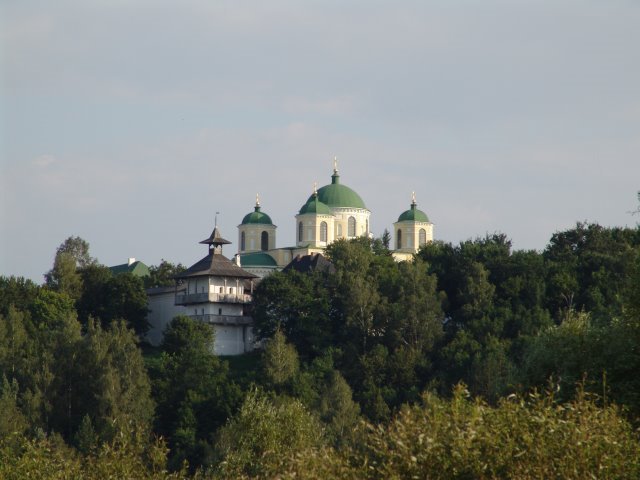
[4; 5]
Chapter II. The places of interest.
2.1. Zamkova Gora (Mount Castle).
Kyivan Rus’ was the youth of our state. Every ancient city had the little fixed part - the kernel of the city. Novgorod-Sivers’kyi was not the exception. Its kernel was located in the center of the city, on a hill by the height of 50m, and by the area of 2 ar. Later, in times of Polish domination, this city was adopted by Zamok, or Zamkova Gora which was surrounded by deep natural ditches from all sides. In the north-eastern Zamkova Gora was washed by the river Desna. It served as the obstacle from the attacks of nomadic tribes. In the south, through a deep ditch, there was a overturned bridge for connection with a environ hail which occupied an area about 30 ar., but was surrounded by defence billows.
The kernel of the city was studied properly during excavations. Tracks of "medushchi" were found here –the large cellar which kept wine, butter and other products. Here were found some means of facilities, spurs, buckles, knives, covered with copper, brushes for horses’ cleaning. It confirms the legend, that there was a princely court exactly on Zamkova Gora. A lot of finds were also found in the X – XIIth centuries, which testify about the stormy development of the city in that period of time. These were the domestic objects: clay, pots, ferrous knives, scissors, sickles, locks, sharp things of bones, spearheads and arrows, elements of horse trappings, fishing hooks, varied decorations from a bone. It all goes to show that able masters appeared in the town blacksmiths, weapon-masters, bone-masters, jewellers. The found wreckages of multicoloured glass crockeries testify about the stormy development of trade. The Old Russian wrote comes into notice, which was made from iron. It was written on a birch bark, or special small planks. The wreckages of potteries with the scratched letters were found, too. Presumably, proprietors noticed the things in such a way. All talks about the development in Novgorod-Sivers’kyi the written language in the X – XIIth centuries.
In 1097 by the decision of Lyubech convention of the russian princes the city became the hail of Sivers’kogo principality of destiny, in the complement of which entered Kurs’ki, Trubchevs’ki, Bryans’ki, Putivl’s’ki, Rul’s’ki earths. Oleg Svyatoslavich in "Slovo o Polku Igorevom" became the first prince in the town.
Novgorod-Sivers’kyi is the family nest of the prince Igor, who borned here on the territory of Zamkova Gora, on April, 23, 1151. His name is George. In 1180 he became the prince of Novgorod-Sivers’kyi, where he reigned 18 years.
In reply to frequent encroachments of polovtsiv on Kyivan Rus’, which especially increased in the end of the XIIth century, in 1183 there was the organized hike of russian princes against nomads. The Kyivan prince Svyatoslav led a hike. Polovtsi were raided, 700 soldiers were captivated. The prince Igor of Novgorod-Sivers’kyi took part in the hike, too. In 1184 russian princes defeated polovtsi. Igor was not able to take part in this hike, prevented icy surface. In autumn, in 1185, Igor began to prepare to the new hike. Vsevolod, Igor’s brother, son Volodumur from Putivl and nephew Svyatoslav, reined in Rul’s’k, took part in a general hike. There were 8 thousand warriors. On April, 23, on Tuesday, 1185, there was the service in the Spaso-Preobrazhens’ky Cathedral (according to folk translation) and Igor went on the trek. The sun eclipse happened, when they were crossing the river Donez. It was considered to be the predecessor of hoodoo in Kyivan Rus’. But it did not influence on the decision of the princes to continue their hike. Two days Igor expected for Vsevolod, who went another way-from Trubchevs’k through Kurs’k. The hike proceeded. The first collision with polovtsi took place at the river of Salnuzya. The last were broken and many of them were captivated. But polovtsi regiments, like a dense forest, surrounded the russian regiments next morning (according to the ipatievs’k chronicle). The russian regiments exulled the amount of polovtsi in 2-3 times. The battle with polovtsi was not stopped two days and two nights. The russian regiments fought bravely, but they were moved by polovtsi from water. People, and especially horses, languished from thirst. Igor was injured in the left arm there. The raws of russian people melted quickly. Igor’s regiment was raided to the end of the second day of the battle. Only 15 combatants succeed to pull through. First, in all history of fight against polovtsi, the russian princes found themselves in a captivity. Russian people have not yet known such defeat. That defeat opened a way to new, more awful attacks of nomads on Rus’. Igor, who was injured, was taken in a captivity by his former accomplice, the khan Conchak. In the prison Igor had relative freedom; he was guarded by 20 sentinels. He rode on hunts with them. The prince could escape from the captivity, but he considered his escape to be a dishonourable way. Only after the fact, when Louvre, one of polovtsi, brouht to Igor news that violence above russian prisoners was preparing after the unsuccessful campaign on Rus’ – Igor carried aut his escape. Eleven days he made his way to the boundary city of Donez,escaping from pursuers. The poem “Slovo o Polku Igorevom”, which is about the unsuccessful Igor’s campaign, was written by an unknown author and, maybe, by the participant and eyewitness of all these events. It is pierced by the ardent appeal of the author to the princes to finish intestine wars, and to unite for the fight against ezternal enemies.
The monument to Boyan, to the court singer of the second part of the XIth century, was set on the celebration of 1000 years anniversary of Novgorod-Sivers’kyi. There are all grounds to consider that Boyan was in Novgorod-Sivers’kyi, because he was the favourite person of Oleg Svyatoslavovich. The author of the monument is a sculptor, folk artist O.V.Cushch, the artchitects are M.I.Baranov’skyi, V.V.Pavlenko. The scientific consultant is N.S. Bynack with the partcipation of the architect O.M.Baranovs’kyi. Unfontunately, the monument is not historically reliable, because Boyan could not be a combatant, as he is represented by the authors. The monument to Boyan, set in Trubshchevs’k, is more successful in this plan.
In 1191 Igor carried out a hike on polovtsi again, raided them and got back with rich preys and plenty of prisoners. From 1198 till 1202 years Igor was the prince of Chernigov, where he died. In 1239, during the invasion of Mongol-Tatar, all structures were burned on the territory of the kernel. Any tracks of labour activity of a man were not discovered here by archaelogists during the next ages up to the middle of the XVIIth century. A saltpetrous factory, which made a saltpeter for Shostka, worked here in the middle of the XVIIIth century. At the beginning of the XIIth century Novgorod-Sivers’kyi namisnytstvo was finally divided into some small destinies, such as: Kurs’k, Trubchevs’k, Putivl’s’k, Rul’s’k. Afterwards the city entered the complement of Bryansk namisnytstvo. In 1223 Novgorod-Sivers’kyi regiment, headed by the prince Izyaslav, took part in a Novgorod-Sivers’kyi battle on Cal’ka against Mongol-Tatar masses. The incorporated russian regiment was raided. The prince Izyaslav Volodumurovich died, too. Oleg Vsevolodovich (1223 – 1239) was the last prince of Novgorod-Sivers’kyi and afterwards the city left off to be the capital of the namisnystvo. In 1239 Novgorod-Sivers’kyi was captivated by Mongol-Tatar and finally blasted. After it up to 1380 there was no information about the development of the city. It is know from some writing sources that in the middle of the XIXth century the city was taken by Lithuanians, headed by the king Ol’herd. Up to the middle of the XVth century the city belonged to the representatives of the Lithuanian great dynasty. There was no information about the socio-economic development of the city. It is known that habitants continued to be engaged in handicrafts, trades, agriculture.
During two ages (mid.XV- mid XVIIth centuries) the city experienced some traumatic events. It passed from Lithuanians hands to the hands of Poland, and to Russia and vice versa. Tatars attacked the city in that period of time. The city was fully collapsed and burned few times, but it was recommenced over and over. Only after the long-term domination of Poland here, in 1648, during the national liberation, the city was released from the power of Poland due to the Zaporozhian cossacks, headed by the colonel Rodack.
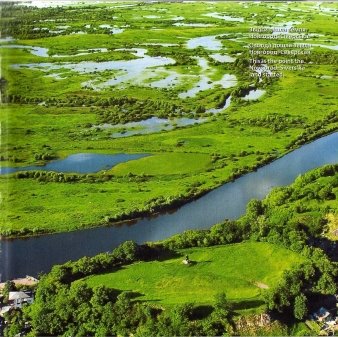
[7; 2]
2.2. The Nikol’s’kaya Church.
In the XVIIIth century the city considerably became widely. Bilding, mainly, was conducted from a tree. The lines of original Ukrainian architecture were exactly showed in the wooden bulding. Some wooden churches with the center-vertical composition appeared in the XVIIIth century on the left-bank Ukraine, and especially in Chernigiv Region. The Nikol’s’kaya Church belongs to this type. A modern church was built in 1760 on the place of the old-Russian stone church (1086), which was blasted in the XIIIth century by Mongol-Tatar invasion. According to the legend, the wooden idol of Siverian stood on this place. A church has the name in honour of Nick Merlyis’kyi – the protector of navigators, merchants, farmers. The height is 19.8m and seems considerably more high: illusion of motion uphill achieves due to vertical composition of lateral frames and walls, which bend just a bit in the middle. This gives not only firmness to the monument, but also strengthens up-stroke. It has many – tier completion: the bath-house is a top, which consists of two bends and flashlight with a poppy head. Lately such system of structure passed to stoning building. Frontons, cornices, platbands are decorated by a screw-thread in the type of “indents”, “fir-trees” which remind a network on the Ukrainian linen shirts. Three original doors with cut corners, which remind an iconostasis, conduct in the church.
The modern type of the church is the result of alteration of the XIXth century and of repair-restorations works of the 60th. The church takes the deserving seat among the similar monuments of wooden architecture on the Left-bank Ukraine. Four of them are saved.
On the territory of the Nikol’s’kaya Church there are the graves of the family of Pumphins, who were engaged in planting of greenery in our city. They were buried here, as a token of gratitude. The land lord Pumpkin personally corresponded with L.Tolstoyi and I.V.Michyrin – the well-known biologist and selectionist. The monument is made from the polished granite, as the trunk of a tree, and has the chopped branches: life has finished – this monument is read in such a way.
In the second part of the XVIIth century at the beginning af the XVIIIth century the city grew into the noticeable point-of-sale-handicraft center of Siveriya. Large development was acquired by handicrafts and trades more than 400 artists of different specialities( shoemakers, tailors ) worked in the town at the beginning of the 80th century. 25 wineplaces, several mills were in the town. The year-boots were erected on a local pier. Those were the canoes with load of 5 thousand poods and more. The comfortable location of the city on the river Desna created the favourable terms for development of trade. One drove forest, ropes, linen, wares from iron, sugar, bread, French wines, and other commodities here, down the river, from the russian cities of Bryans’k, Trubchevs’k, Caluha. Merchants from Novgorod-Sivers’kyi drove to sell lime, chalk, stump, stone, vodka, hemp butter. Auctions were settled two times in a week, fairs were three times per a year. Sometimes they proceeded two or three weeks. Merchants went here from Moscow, Caluga, Nizhyn, Rul’s’k, Starodub, from the South of Ukraine, Kuban, Don. About 100 varied benches, and 80 pubs were counted in the town.
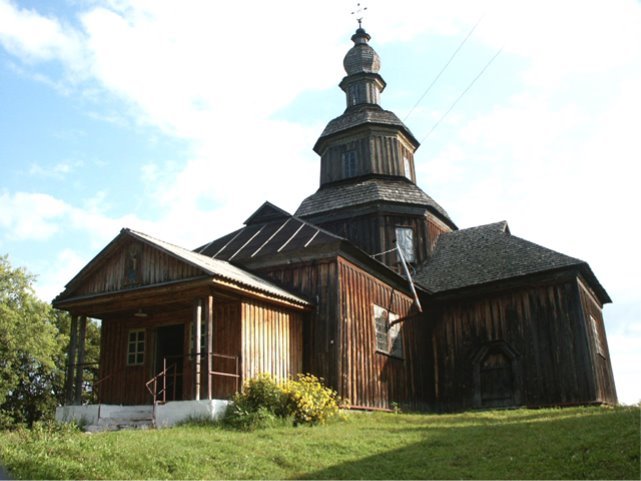
[3; 159]
2.3. The Market places and warehouses.
The market places, contracts houses and exchanges were built in the XVIIIth century for the necessities of the developed trade in the town. One can see two structures of the warehouses with very simple design, decorated by the arch galleries, niches, cornices. A frame is parted by transversal walls on identical apartments by their sizes. These are “shops”. There are some compositions opposite the warehouses. The city became the “soten city” of Nizhyn, and then of Starodub regiment after the relief in 1648 by Zaporozhian cossacks. In 1654 inhabitants of Novgorod-Sivers’kyi adopted the oath of allegiance to Russia in the Uspens’kyi cathedral.
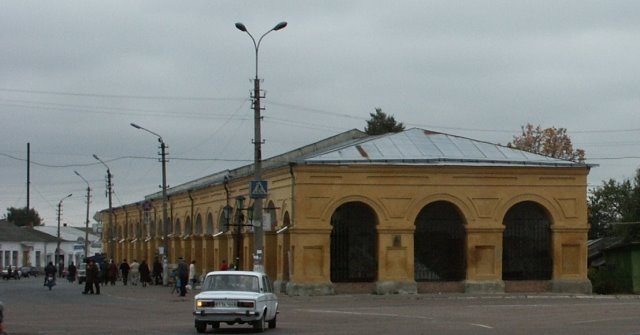
[5; 67]
2.4. The Uspens’kyi Cathedral.
It is the architectural monument of the end of the XVIIth – mid of the XVIIIth centuries. Built on the place of the heathen metallic idol of siverian, which was down faulted into water of Desna after acceptance of christianity. The monument is cruciform in a plan, has five domes, the central dome considerably exceeds lateral domes on its sizes. The cathedral was built on facilities of local bourgeois. It was represented on the aesthetically beautiful and artistic features of the monument. The bell-tower was built considerably later, in 1820. The cathedral is buit in style of baroque. The influence of local tastes and Kyivan architectural school reflect here.
The officer apex of Ukraine, headed by the hetman of Ukraine, I.Mazepa, carried some plans to unite the Left-bank and the Right-bank Ukraine, and to create the independent irrespective from Russia with the help of Swedes. It was in the first years of the north war. By the agreement, Mazepa was obligated to give help by army and food to Swedes, to pass cossack regiments and fortresses (Novgorod-Sivers’kyi, Baturin, Starodub) in their order.
In October, 1708, when front-rank parts of Swedish troops walked up to Desna in the village of Mokoshino, Mazepa passed to the side of Swedes (in the village of Girky). Two thousand cossacks passed together with him.
Having known about treason of the hetman, Peter I gave the order about elections of a new hetman. On November, 7 Ivan Skoropads’ryi was selected to be a hetman. Having known about Mazepa’s actions, the habitants of the city damned him in the cathedral and wrote the letter to Peter I with a request to help in defence of the city. At night, through the horunzhyyi Hudorbayi, the letter was passed to the headquarter of Peter I, which was in 7km from the city, in the village of Pogrybky. The large detachment, headed by the command of the colonel Chernyshov, was sent in the city. The soldiers came here through the aquatic gates. The detachment of Swedes (7 thousand) did not manage to lay hands on the city. Soon, marshal Sheremet’ev fastened fight on Swedes under the village Slobidka. Afterwards they stepped back and crossed the river Desna in the district of the village of Dehtyarivka.
There are some translation about the visit of our city by Peter I. Bishop Lisovs’kyi decided to organize the solemn meeting devoted to Peter I. He collected people, aborned the procession beautifully. The regiment of Lisovs’kyi went first, carried the jug with honey. But having seen the great figure of the tsar (his stature was 2.4m), the poor woman lost her head and admitted the jug. Lisovs’kyi came for help. He walked up to Peter I and said “Well, our great tsar, your enemies will be broken and trampled in such a way, as this jug”. Peter was staggered by such meeting. Afterwards, after the victory under Poltava, Peter I sent a silver glass with his portait and initials as a present to people of Novgorod-Sivers’kyi. That jug was kept in one of the churches of the city by 1922 and then its tracks disappeared.
We are driving through a former market-place, now this area has the name of Lenin. The monument to Prince Igor Svyatoslavovich of Novgorod-Sivers’kyi was built here in honour of the 1000-years-old anniversary of the city.

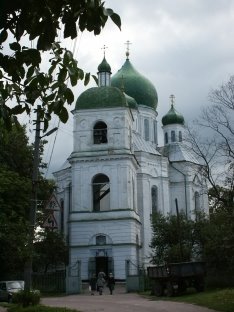 We are passing nearby one of the most beautiful stoning buildings of city the house of the merchant Medvedev, built in style of eclecticism (the combination of all styles). The house was built by the local master I.I.Loshakov. The local child’s library, the library for adults are placed now here. Coming down the street of K.Marksa (the former name was Hubernyts’ka), we are approaching to the Triumphal arch.
We are passing nearby one of the most beautiful stoning buildings of city the house of the merchant Medvedev, built in style of eclecticism (the combination of all styles). The house was built by the local master I.I.Loshakov. The local child’s library, the library for adults are placed now here. Coming down the street of K.Marksa (the former name was Hubernyts’ka), we are approaching to the Triumphal arch.
[3; 160 – 161]
[5; 19 – 20, 74]
2.5. Triumphal arch.
The arch was built in 1786-1787 in honour of passage of the empress Catherine II. The author of the project is unknown. Due to the design of the colums, which repeated then in the Spaso-Preobrazhens’ky cathedral, one assumes that the Italien architect G.Quarengi could be its author.There is no exact information about it. The arch is the easy travel, decorated by cornices, colums, caps in an architectural plan. Some large niches decorate the arched travel. The “pilony” with two bells pontico are placed on the both sides of the arched travel. The arch was built on facilities of Novgorod-Sivers’kyi noblemen..
The inculcated allrussian forms of rule were established by Catherine II in 1782 on the Left-bank Ukraine. Ukraine was divided into three deputies: Kyivan, Chernigv, Novgorod-Sivers’kyi. The life of the Novgorod-Sivers’kyi deputy lasted 15 years. Then, in 1796, it was anniented, and the city entered the complement of the Small-Russian province. Afterwards, in 1802, it entered the Chernigov province. The coats of arms of the districts, which entered the Novgorod-Sivers’kyi deputy, are placed on the oval medallions. The coas of arms was given to our city in 1620 in connection with the introduction of Magdeburg law, which gave the city the right to self-government. The localities are represented in the “terby”, and the gold spear and the sabre are shown on the both sides of the arch. Novgorod-Sivers’kyi, as it is known, was a fortress, which consisted of the city and the fish-fork, which are united between themsetves by the known “jails gates” – the gate. Except for it, the town had also the Chernigiv gate, which conducted westward, and the Kurs’ky (Glukhivs’ky) gate, which conducted southward. Possibly, these ancient fortresses buildings were fixed on the city coat of arms of Novgorod-Sivers’kyi. There are some other reasons due to which the similar architectural buldings were included to the city coat of arms. They also symbolize the defensive of the city from enemies. Not once the habitants of Novgorod-Sivers’kyi defended the city from hostile attacks. They survived the especially protracted siege in autumn, in 1604, when the impostor Grigoryi Otrep’ev trided to lay his hands on the city with the hired army of Poland. Posssible, this event is the main plot of the coat of arms. The interesting story about this event was kept. It was written by the unknown author of the XVIIIth century. This story tells “Due to this event the town has the coat of arms with the representation of the town’s wall with the tower. One can see the stars, the golden sword and spear here”.
The triumphal arch underlines the value of the city, as the centre of the namisnytstvo.
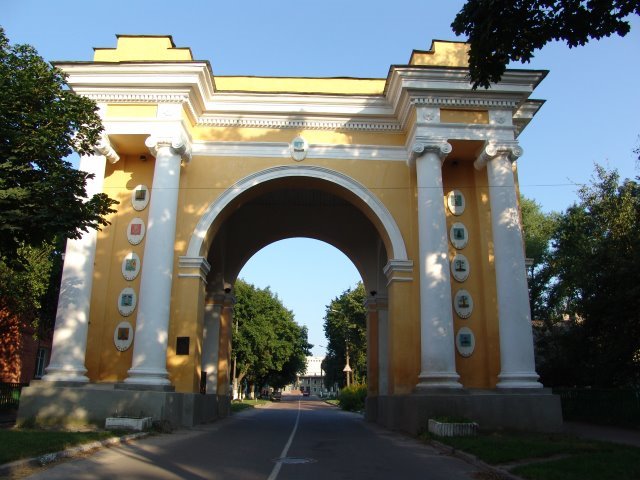
[ 3; 64 – 65]
2.6. The Masculine high school.
In the second part of the XVIIth century – at the beginning of the XVIIIth century the city was not only the considerable shopping center in the north of Ukraine, but also the known civilized manner – educative center.
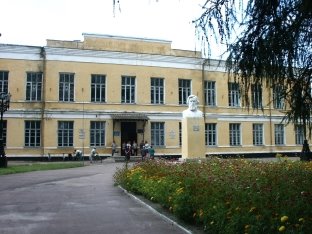
The first society educational establisment was opened in the city in 1789. It was the main folk school, first with the 4th annual term of studies, and then with the 7th annual term. A new building was built for the high school in 1844. Now the state high school is located here. Before it was the boarding school. The teaching was conducted on very high level. It was one of the best educational establishment of that time not only in Ukraine, but also in Russia. Many famous people studied here. For example, the first rector of the Kyivan University, one of the firsr translators of “Slovo o Polku Igorevom” on poetic Ukrainian; the scientist – encyclopaedist M.O.Maksimovich; the great russian teacher, the founder of the russian pedagogics and folk school K.D.Ushyns’kyi; the Ukrainian writers M.K.Chaluyi, P.Kulysh; the folk – masters M.I.Kubal’chych, O.D. Muhayilov, the revolutionaries M.O.Olekseev and O.I.Svyders’kyi (the unique one from Novgorod-Sivers’kyi, buried at the Kremlin wall) and others. I.F.Tymkovs’kyi, the professor of the Kharkov University, was one of the headmasters of the school and the graduating students of Novgorod-Sivers’kyi high school could enter the Kharkov University without entrance examinations due to his patronage . The letter of Maksimovich, the rector of the Kyivan university, written to Tymkovs’kyi tells about the value of this high school, as the educational establishment “I would like to let you know with a great pleasure that your university, which has already thanked you for zealous attention you have given it, must bring the best students to your great gymnasium”
After the abolition of the gymnasium in 1917 the factory – plant college, and then the seminar school took place here. The pedagogical technical school was translated here from Mohylov – Podil’s’k in 1931. Since 1956 the boarding – school began to work here, which got the name of Ushuns’kyi in 1974. This educational establishment celebrated the 200-years-old anniversary of its existence in 1989. In 2004 the school acquired the status of the state high school.
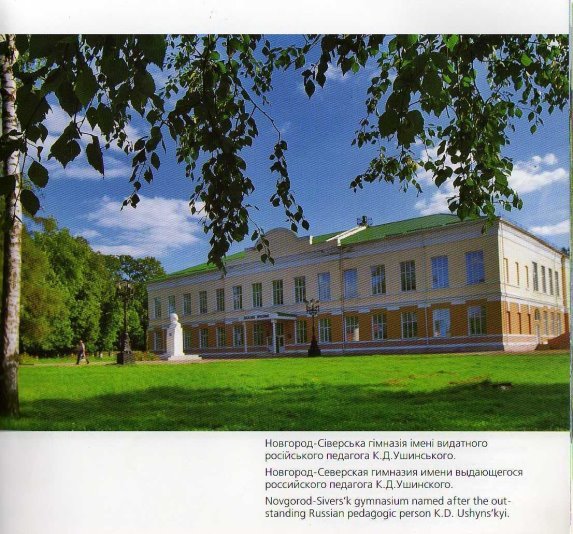
[3; 106]
2.7. Novhorod-Sivers’kyi Spaso-Preobrazhens’kyi monastery
And now we are approaching to one of the uniquest architectural complexes on the Left-bank Ukraine-to the Spaso-Preobrazhens’kyi monastery. The word monastery means “loneliness”, “cell”. Novhorod-Siverskyi Transfiguration Monastery (Novhorod-Siverskyi Spaso-Preobrazhens’kyi monastery). (Photo: Transfiguration Monastery complex.) Amen's monastery on the bank of the DesnaTSver in southeastern Novhorod-Siverskyi, believed to have been founded in 1033 by Prince Mstyslav Volodumurovich of Tmutorokan. The first mention of the monastery is found in a 1552 charter of Ivan the Terrible, written when the city was under Muscovite rule. From the first half of the 17th century the monastery was headed by an archimandrite. In 1635, under Polish rule, it was given to the Jesuit order, but it reverted to Orthodoxy following the outbreak of the Cossack-Polish War in 1648. From 1657 to 1672, while serving as the archbishop of Chernihiv, Lazar Baranovych resided at the monastery. He had new buildings erected and established the Novhorod-Siverskyi Press. Baranovych also acquired more properties for the monastery, so that in the 18th century it owned approx 6,000 serfs. From 1785 to 17991. Kondratkovsky, the bishop of Novhorod-Siverskyi and Glukhiv, resided at the monastery. He closed down Pereiaslav College and in its place created a theological seminary at the monastery. The seminary's first rector was Varlaam Shyshatsky. In 1908 the monastery housed 38 monks.

Under Soviet rule the monastery was secularized and transformed into a cultural-historical preserve. Its central attractions are the monastery's second Transfiguration Cathedral, designed in the classical style by Giacomo Quarenghi and built with five cupolas in 1791-6; the 16th- to 17th-century cruciform, one-cupola Saints Peter and Paul Church; and the monastery's main gate, with three entrances, arches, and an octagonal bell tower, built in the baroque style in the late 17th century. Many prominent 18th- and 19th-century statesmen and cultural figures (eg, Count O. Rozumovsky, Archbishop Shyshatsky) were buried at the monastery.

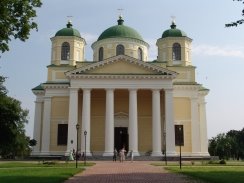
Novhorod-Siverskyi Press (Novhorod-Siverska drukarnia). An imprimery founded and funded by Archbishop Lazar Baranovych in 1674 at the Novhorod-Siverskyi Transfiguration Monastery. It published the polemic and moralizing works of L. Baranovych and Ioanikii Galiatovsky, the Antolohion, O. Buchynsky's poem “Chyhyryn” (1677), about the heroic defense of the city from Turkish and Tatar armies, and primers and other educational texts. In 1679 it was moved to
Chernihiv and was reorganized into the Chernihiv printing press.
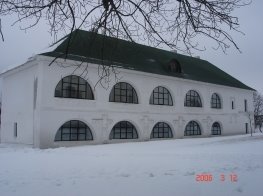
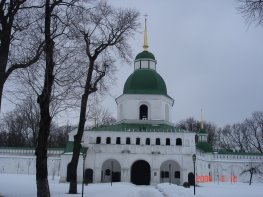
[ 1; 189 – 192] [3; 60 – 61, 150 – 158] [6, 35 – 36]
2.8. Some other places of interest.
The Palace of Culture was built in our town in the end of the 70th century. The monument to V.I.Lenin (the authors: V.S.Tofan and I.S.Znoba) was set before it in 1985. The monument to T.G.Shevchenko, the garten-part artist, is located on the right hand of us. There are the graves of the known russian author I.M.Uralov here. Uralov arrived on a permanent residence in our city in 1919. He created a dramatic theatre here with A.A.Asingom, the theatregoer and patron of art. It was one of the first dramatic theatres, built in times of Soviet power in Ukraine. Uralov died in 1920 at the age of 48 years old.
The decision, concerning the opening in a central park the avenue in honour of 9 heroes of Soviet Union, the persons from Novgorod-Sivers’kyi was accepted to the day of cerebration of 1000-years-old anniversary of the city. The busts to heroes of the was established on the high columns.
There was situated sanatorium “Desna” one the left hand of us Earlier children rested and received treatment here. The sanatorium was situated on the territory of the former nobleman M.I.Sudienko.
But Novgorod-Sivers’kyi is not only the past-the Slavyansky Hotel and the new road terminal are definitely the architectural landmarks of the 21st century.
In 2004, the presidents of Russia, Belarus and Ukraine – Putin, Lukashenko and Kuchma – had a summit in Novgorod-Sivers’kyi (President Leonid Kuchma of Ukraine hails from Novgorod-Sivers’kyi)
Those who are of a more sportive hind are welcome to take a swim in the waters of the Desna River. Everybody who has done it, claim it was great.
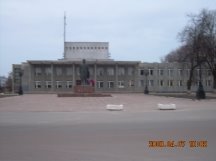 This city is not an industrial giant but ih has a different mission-to maintain the national spirit and preserve the historical heritage.
This city is not an industrial giant but ih has a different mission-to maintain the national spirit and preserve the historical heritage.
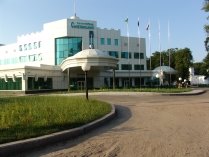
[5; 55] [6; 46 – 47] [7; 56 – 59]
Conclusion.
There are the places on our blessed Siveryan land, which were and remain the existing implementation of the historical memory, the endless source of the spiritual inspiration for many generations, as well as out-of-time sacred things for every patriot of the native region. Nowadays, it fully relates Novgorod-Sivers’kyi – the Siveryan tribes’ former capital, one of the main advanced post of the Eastern Slavonic powerful state – Kyivan Rus’
The entire centuries have passed over the hills near Desna, on which the Prince Igor’s capital city stands proudly. And even today each stone breathes with the history – the long one and not long, amazing us by its high spirit and thoughts which are implemented in cultural monuments, in the immortal “Slovo o Polku Igorevom” (the story of Igor’s military unit), and in later heritage. The natural beautiful landscapes, charmed Desna pure water, the attention paid to the tourist infrastructure development and population’s hospitality should be added.
The city has many things to offer to tourists and students local history, people on rest and visitors – the historical and cultural monuments, the industrial and social structures, the natural – reserve object of the Novgorod – Sivers’kyi region as well. Novgorod – Sivers’kyi is the city – memory, city – warrior, and city – worker. Nowadays, as well as in the past times, it can overcome difficulties and work for the perspective.
Novgorod – Sivers’kyi is famous not by the Prince Igor and Yaroslavna’s names, Yaroslavna was his wife, but by numerous state, church and cultural personalities of the times, great warriors and talented workers who were born, worked or studied here. Their heirs today make many efforts in order to leave the treasury of the city and to the city’s future.
[7; 3 – 4]
Literature.
- Малаков Д.В., Дерлеменко Є.А. По історичних містах Київської Русі.: фото- путівник .- К.: Мистецтво, 1980. – 311с.: іл..
- Томашев М.С., Сугоняко М.М. Сіверщина в долі істориків та в історичних дослідженнях: Київ – Новгород-Сіверський, 1998. – 101с.
- Новгород – Северский: город десяти веков: фотопутеводитель. Авт. текста А.М. Федирко; Фото М.К. Андреева и др. – К.: Мистецтво, 1989. – 167с.:ил.
- Новгород – Сіверський: Фотоальбом/ Упоряд., фото і макет І.М.Корзуна; Авт. тексту В.В. Зінов‘єв. – К.: Мистецтво, 1985.- 79с., іл.
- Воїнов С. Новгород-Сіверський: Нариси історії/ Ред. О.Б. Коваленко. – Чернігів. Сіверянська думка. 1999. – 164с.
- Новгород – Сіверський – любов моя. Коротка фото ілюстрована історія землі Сіверської. [Книга – альбом] Автори тексту М.С.Бунак, А.М. Федірко, упоряд. Ілюстрат. Матер. М.С. Бунак, - К: Мистецтво.
- М.Тищенко. Новгород – Сіверський - столиця Сіверського краю. Фотоальбом. Мена 2007. Домінант.
1


про публікацію авторської розробки
Додати розробку
